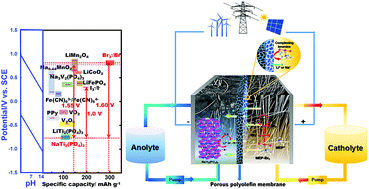A novel aqueous Li+ (or Na+)/Br− hybrid-ion battery with super high areal capacity and energy density†
Abstract
With the explosive growth in intermittent renewable sources and the global drive toward decarbonizing the energy economy, reliable large-scale electrical energy storage technologies with high safety and low cost are urgently needed. Aqueous batteries hold the intrinsic advantages of nonflammability and low cost; the zinc//bromine flow battery and LiMn2O4//NaTi2(PO4)3 aqueous rechargeable ion battery are two representative systems with relatively high voltages (1.6 V to 1.8 V in common aqueous solutions). However, the long-term cycling stability of intercalation/de-intercalation type cathode materials is easily impaired by pH fluctuance, while the deposition/dissolution-type zinc anode suffers from zinc dendrites and uneven deposition issues. To avoid these two issues, we propose a novel bromine//NaTi2(PO4)3 hybrid ion battery, involving an aqueous redox pair (Br3−/Br−, with high reactivity in a pH range from 0 to 9) and a high-loading ion intercalation anode (NaTi2(PO4)3, with low working voltage and little volume change). First, the high-performance NTP@C nanoparticles are synthesized by a modified sol–gel method. Then, the three-dimensional NTP@C anode with super high mass loading is designed by employing a porous and conductive carbon substrate. The crossover of bromine in aqueous catholyte is suppressed by an effective bromine complexing agent and the insufficient ion transport in a thick solid anode is conquered by a negative flowing electrolyte. As a result, the hybrid ion battery shows high areal energy density, high power density and promising cycling stability. The full cell can deliver a high energy density and power density of 12.8 mW h cm−2 (109 W h kg−1 based on NTP@C and reacted LiBr) and 29.4 mW cm−2 (250 W kg−1 based on NTP@C and reacted LiBr), respectively. Moreover, the power density can reach 106 mW cm−2 with energy density remaining at 7.95 mW h cm−2 (68 W h kg−1 based on NTP@C and reacted LiBr) at a super high current density of 100 mA cm−2. An average capacity loss of 0.075% per cycle is obtained during a 200-cycle test, demonstrating the great feasibility of the new system. Therefore, this hybrid battery has great potential in large scale electrical energy storage.



 Please wait while we load your content...
Please wait while we load your content...